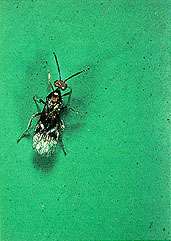Habrobracon hebetor
| Habrobracon hebetor | |
|---|---|
 | |
| Scientific classification | |
| Kingdom: | Animalia |
| Phylum: | Arthropoda |
| Class: | Insecta |
| Order: | Hymenoptera |
| Family: | Braconidae |
| Genus: | Habrobracon |
| Species: | H. hebetor |
| Binomial name | |
| Habrobracon hebetor (Say, 1836) | |
| Synonyms | |
Habrobracon hebetor is a minute Braconidae wasp that is an internal parasitoid to the caterpillar stage of Plodia interpunctella, the Indian meal moth, in the late larval stage of the Mediterranean flour moth and the almond moth.[4][5]
Use in biological control
The gut enzymes from the Habrobracon hebetor wasp quickly destroy the blood proteins in the moth larvae; thus it is an effective biocontrol agent.[6]
Life cycle
At 30 °C (86 °F), the life cycle of the wasp is about ten to thirteen days from initial parasitism to final emergence of the adult. The adult female parasite lives about 23 days during which it produces about 100 eggs. It deposits 1 to 8 eggs in individual paralyzed late instar moth larvae.
Radiation
Habrobracon hebetor is remarkably resistant to radiation. While it takes 400-1000 rads to kill a human , and 56,128 rads (64,000 roentgens) to kill the fruit fly Drosophila melanogaster,[7] a study showed that H. hebetor survived X-ray radiations of 158,080 rads (180,250 R). In this study, irradiated groups had an increased life span compared to non-irradiated control groups.[8] An effect also noticed in other insect species.[9] However, female H. hebetor were sterilized at 4,385 rads (5,000 R) exposure.[10] Another study showed that 218,373 rads (249,000 R) exposure instantly killed 100% H. hebetor.[11]
References
- 1 2 3 http://bugguide.net/node/view/238510
- 1 2 http://www.taxapad.com/local.php?&indexstartGS=95615&taxgroupGS=ichneumonoidea
- 1 2 http://www.taxapad.com/local.php?&indexstartGS=95591&taxgroupGS=ichneumonoidea
- ↑ Biological Control of Insects Research by D. Stanley
- ↑ USDA Agricultural Research Service ARS, "Bracon Hebetor Biological control agent for stored product pests", Ames Iowa. 1998.
- ↑ "Biological Control of Stored-Product Pests" Midwest Biological Control News (University of Wisconsin)
- ↑ Hassett C. C., Jenkins D. W., 1952. Use of fission products for insect control. Nucleonics, Vol. 10, p. 42-46
- ↑ Sullivan R., Grosch D., 1953. The radiation tolerance of an adult wasp. Nucleotics, Vol. 11, p. 21-23
- ↑ Davey W. P., 1919. Prolongation of life of Tribolium confusum apparently due to small doses of X-rays. Journal of Experimental Zoology, Vol. 28, p. 447-458
- ↑ Sullivan R., Grosch D., 1953. The radiation tolerance of an adult wasp. Nucleotics, Vol. 11, p. 21-23
- ↑ Heidenthal G., 1945. The occurrence of X-ray induced dominant lethal mutations in Habrobracon. Genetics, Vol. 30, p. 197-205